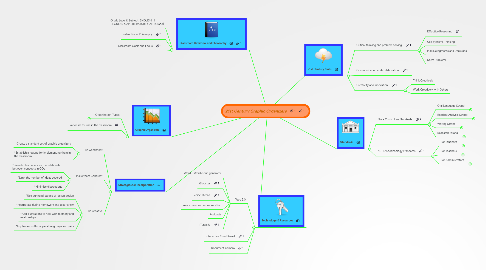
1. Strategies for incorporation
1.1. Be Consistent
1.1.1. *Create a standard set of graphic organizers
1.1.2. *Establish a routine for implementing them in the classroom.
1.2. Make them Coherent
1.2.1. *Provide clear labels for the relationship between concepts in GOs
1.2.2. *Limit the number of ideas covered
1.2.3. *Minimize distractions
1.3. Be Creative
1.3.1. *Use during all stages of lesson design
1.3.2. *Incorporate during homework and test review
1.3.3. *Add illustrations to help with memory and relationships
1.3.4. *Implement with cooperative groups and pairs
2. Classroom Overview and Philosophy
2.1. Grade Level & Subject: ENGLISH 11 REGULAR & AP LITERATURE (12TH Grade)
2.2. Instructional Philosophy
2.3. Classroom Goals and Focus
3. GraphicOrganizers
3.1. Organization Types
3.1.1. Character Map Helps describe in detail the main character, their thoughts and actions. Good for short stories and novels.
3.1.2. Clustering Good for organization of concepts, ideas, and as a pre-reading activity.
3.1.3. Compare/Contrast Helps with similarities and differences in characters, situations, and concepts.
3.1.4. Concept Map Good pre-writing activity. Helps with organization of main ideas and details.
3.1.5. Cornell Note-taking Good for organizing information gained from reading textbooks or expository materials.
3.1.6. Fishbone Good for organizing details and events through cause and effect.
3.1.7. Hypothesizing Good in helping to identify the three main components of an hypothesis.
3.1.8. K-W-H-L Chart Good for tapping background information prior to introducing a new concept.
3.1.9. Plot Diagram Good for diagramming and outlining the plot and elements of a story.
3.1.10. Sequence of Events Chart Good for placing main events in their order of occurrence.
3.1.11. Spider Map Helpful with organizing several ideas with supporting details.
3.1.12. SQ3R Good reading strategy used to comprehend expository material.
3.1.13. Story Map Helps with the outline or blueprint of a fictional story.
3.1.14. Storyboard Helps to illustrate the main events.
3.1.15. Timeline Helps with sequencing events in their proper order.
3.1.16. Tree Helps with connections about different ideas and details. Useful when background knowledge is limited.
3.1.17. Venn Diagram Good for comparison of ideas, concepts, and character traits. Useful as a pre-writing activity.
3.1.18. W's Organizer Helps with organizing factual ideas around the 5 main questions: who, what, where, when and why.
3.1.19. Web Helpful with developing a framework for ideas and concepts. Useful pre-writing activity.
3.1.20. Web Site Profiler Useful tool for helping to evaluate the quality of information on a web site.
3.1.21. Wheel and Spoke Diagram Helpful with developing a framework for ideas and concepts. Useful pre-writing activity.
3.2. Rationale for use in the classroom
4. Technology & Resources
4.1. Web 2.0
4.1.1. Wordl - Word cloud generator
4.1.2. Glogster
4.1.3. Voice Thread
4.1.4. Asynchronous communication
4.1.5. Podcasts
4.1.6. iTunes U
4.2. Interactive SmartBoard
4.3. Document Camera
5. 21st Century Skills
5.1. Critical thinking and problem solving
5.1.1. Effective Reasoning
5.1.2. Use Systems Thinking
5.1.3. Make Judgments and Decisions
5.1.4. Solve Problems
5.2. Communication and collaboration
5.3. Creativity and innovation
5.3.1. Think Creatively
5.3.2. Work Creatively with Others
6. Standards
6.1. State Curriculum Standards
6.1.1. Oral Language Strand
6.1.1.1. 11.1 The student will make informative and persuasive presentations.
6.1.1.2. 11.2 the student will analyze and evaluate informative and persuasive presentations
6.1.2. Reading Analysis Strand
6.1.2.1. 11.3 The student will read and analyze relationships among American literature, history, and culture.
6.1.2.2. 11.4 The student will read and analyze a variety of informational materials.
6.1.2.3. 11.5 The student will read and critique a variety of poetry.
6.1.2.4. 11.6 The student will read and critique a variety of dramatic selections.
6.1.3. Writing Strand
6.1.3.1. 11.7 The student will write in a variety of forms, with an emphasis on persuasion
6.1.3.2. 11.8 The student will edit writing for correct grammar, capitalization, punctuation, spelling, sentence structure and paragraphing.
6.1.3.3. 11.9 The student will write, revise, and edit personal, professional, and informational correspondence to a standard acceptable in the workplace and higher education.
6.1.4. Research Strand
6.1.4.1. 11.10 The student will analyze, evaluate, synthesize, and organize information from a variety of sources to produce a research product.
6.2. NETS*S technology standards
6.2.1. For Students
6.2.1.1. Creativity & Innovation
6.2.1.2. Technology Operations
6.2.1.3. Digital Citizenship
6.2.1.4. Critical Thinking
6.2.1.5. Research & Information
6.2.1.6. Communication & Collaboration
6.2.2. For Teachers
6.2.2.1. Digital Age Work
6.2.2.2. Digital Age Learning
6.2.2.3. Student Learning
6.2.2.4. Professional Growth
6.2.2.5. Digital Citizenship
6.2.3. For Administrators
6.2.3.1. Digital Age Learning
6.2.3.2. Visionary Leadership
6.2.3.3. Digital Citizenship
6.2.3.4. Systemic Improvement
6.2.3.5. Professional Practice
